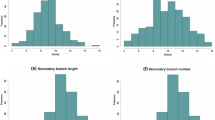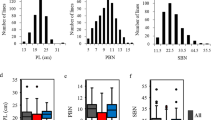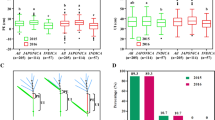Abstract
Panicle length is an important trait for improving panicle architecture and grain yield in rice (Oryza sativa L.). Two populations were used to identify QTLs associated with panicle length. Based on genotypic data including 788,396 single-nucleotide polymorphisms (SNPs), twenty eight lead SNPs significantly associated with panicle length in 2018 and 2019 were detected on chromosomes 1, 2, 3, 4, 6, 7, 9, 10 and 11 in the natural population consisting of 295 japonica rice varieties collected from Northeast Asia. Eight QTLs for panicle length in 2018 and 2019 were detected on chromosomes 1, 2, 3, 6, 7 and 9 through linkage mapping in the recombinant inbred line population derived from a cross between the cultivars Kongyu131 (short panicle) and Xiaobaijingzi (long panicle). Interestingly, Chr6_7539486 identified by GWAS in both years, was located within the same region as qPL6 identified by the linkage mapping. According to LD decay of the whole genome, a 218-kb region on chromosome 6 was selected for further analysis. After haplotype analysis, quantitative real-time PCR and sequence analysis, LOC_Os06g14200 and LOC_Os06g14370 were initially considered as the candidate genes. Moreover, LOC_Os06g14200 encoding a C3HC4 type zinc finger protein containing RING finger domain plays an important role in the growth and development of plants, which was most likely involved in the regulation of panicle length in rice. This study provides resources for breeding aimed at improving rice high yield potential.





Similar content being viewed by others
References
Ashikari M (2005) Cytokinin oxidase regulates rice grain production. Science 309:741–745
Bradbury PJ, Zhang Z, Kroon DE, Casstevens TM, Ramdoss Y, Buckler ES (2007) TASSEL: software for association mapping of complex traits in diverse samples. Bioinformatics 23:2633–2635
Famoso AN, Zhao K, Clark RT, Tung C, Wright MH, Bustamante C, Kochian LV, Mccouch SR (2011) Genetic architecture of aluminum tolerance in rice (Oryza sativa L.) determined through genome-wide association analysis and QTL mapping. Plos Genet 7:747–757
FAO (2017) Food and agricultural organization. Online interactive database on agriculture, FAOSTAT. www.fao.org
Hittalmani S, Huang N, Courtois B, Venuprasad R, Shashidhar HE, Zhuang J, Zheng KL, Liu G, Wang GC, Sidhu JS (2003) Identification of QTL for growth and grain yield-related traits in rice across nine locations of Asia. Theor Appl Genet 107:679–690
Huang X, Wei X, Sang T, Zhao Q, Feng Q, Zhao Y, Li C, Zhu C, Lu T, Zhang Z, Li M, Fan D, Guo Y, Wang A, Wang L, Deng L, Li W, Lu Y, Weng Q, Liu K, Huang T, Zhou T, Jing Y, Li W, Lin Z, Buckler E, Qian Q, Zhang Q, Li J, Han B (2010) Genome-wide association studies of 14 agronomic traits in rice landraces. Nat Genet 42:961–967
Ikeda K, Sunohara H, Nagato Y (2004) Developmental course of inflorescence and spikelet in rice. Breed Sci 54:147–156
Jan A, Kitano H, Matsumoto H, Komatsu S (2006) The rice OsGAE1 is a novel gibberellin-regulated gene and involved in rice growth. Plant Mol Biol 62:439–452
Jiang GH, Xu CG, Li XH, He YQ (2004) Characterization of the genetic basis for yield and its component traits of rice revealed by doubled haploid population. Acta Genet Sin 31:63
Kawahara Y, Bastide M, Hamilton J, Kanamori H, McCombie W, Ouyang S, Schwartz D, Tanaka T, Wu J, Zhou S, Childs K, Davidson R, Lin H, Quesada-Ocampo L, Vaillancourt B, Sakai H, Lee S, Kim J, Numa H, Itoh T, Buell C, Matsumoto T (2013) Improvement of the Oryza sativa Nipponbare reference genome using next generation sequence and optical map data. Rice 6:4
Kobayashi S, Fukuta Y, Sato T, Osaki M, Khush GS (2003) Molecular marker dissection of rice (Oryza sativa L.) plant architecture under temperate and tropical climates. Theor Appl Genet 107:1350–1356
Koiwai H, Tagiri A, Katoh S, Katoh E, Ichikawa H, Minami E, Nishizawa Y (2007) RING-H2 type ubiquitin ligase EL5 is involved in root development through the maintenance of cell viability in rice. Plant J 51:92–104
Li S, Qian Q, Fu Z, Zeng D, Meng X, Kyozuka J, Maekawa M, Zhu X, Zhang J, Li J (2009) Short panicle1 encodes a putative PTR family transporter and determines rice panicle size. Plant J 58:592–605
Li M, Tang D, Wang K, Wu X, Lu L, Yu H, Gu M, Yan C, Cheng Z (2011a) Mutations in the F-box gene LARGER PANICLE improve the panicle architecture and enhance the grain yield in rice. Plant Biotechnol J 9:1002–1013
Li Y, Fan C, Xing Y, Jiang Y, Luo L, Sun L, Shao D, Xu C, Li X, Xiao J, He Y, Zhang Q (2011b) Natural variation in GS5 plays an important role in regulating grain size and yield in rice. Nat Genet 43:1266–1269
Li M, Yeung J, Cherny S, Sham P (2012) Evaluating the effective numbers of independent tests and significant p-value thresholds in commercial genotyping arrays and public imputation reference datasets. Hum Genet 131:747–756
Li N, Zheng H, Cui J, Wang J, Liu H, Sun J, Liu T, Zhao H, Lai Y, Zou D (2019) Genome-wide association study and candidate gene analysis of alkalinity tolerance in japonica rice germplasm at the seedling stage. Rice 12:24
Liu H, Hedley P, Cardle L, Wright KM, Hein I, Marshall D, Waugh R (2005) Characterisation and functional analysis of two barley caleosins expressed during barley caryopsis development. Planta 221(4):513–522
Liu T, Li L, Zhang Y, Xu C, Li X, Xing Y (2011) Comparison of quantitative trait loci for rice yield, panicle length and spikelet density across three connected populations. J Genet 90:377–382
Liu E, Liu Y, Wu G, Zeng S, Tran TTG, Liang L, Liang Y, Dong Z, She D, Wang H (2016) Identification of a candidate gene for panicle length in rice (Oryza sativa L.) via association and linkage analysis. Front Plant Sci 7:596
Livak KJ, Schmittgen T (2001) Analysis of relative gene expression data using real-time quantitative PCR and the 2-△△Ct method. Methods 25:402–408
Lu S, Wei H, Wang Y, Wang H, Yang R, Zhang X, Tu J (2012) Overexpression of a transcription factor OsMADS15 modifies plant architecture and flowering time in rice (Oryza sativa L.). Plant Mol Biol Rep 30:1461–1469
McNellis TW, von Arnim AG, Deng XW (1994) Overexpression of Arabidopsis COP1 results in partial suppression of light-mediated development: evidence for a light-inactivable repressor of photo-morphogenesis. Plant Cell 6:1391–1400
Mei H, Li Z, Shu Q, Guo L, Wang Y, Yu X, Ying CS, Luo L (2003) Gene actions of QTLs affecting several agronomic traits resolved in a recombinant inbred rice population and two backcross populations. Theor Appl Genet 110:649–659
Piao R, Chu S, Jiang W, Yu Y, Jin Y, Woo M, Lee J, Kim SH, Koh H (2014) Isolation and characterization of a dominant dwarf gene, d-h, in rice. Plos One 9:e86210
Septiningsih EM, Prasetiyono J, Lubis E, Tai TH, Tjubaryat T, Moeljopawiro S, Mccouch SR (2003) Identification of quantitative trait loci for yield and yield components in an advanced backcross population derived from the Oryza sativa variety IR64 and the wild relative O. rufipogon. Theor Appl Genet 107:1419–1432
Sun P, Zhang W, Wang Y, He Q, Shu F, Liu H, Wang J, Wang J, Yuan L, Deng H (2016) OsGRF4 controls grain shape, panicle length and seed shattering in rice. J Integr Plant Biol 58:836–847
Thomson MJ, Tai TH, Mcclung AM, Lai X, Hinga ME, Lobos KB, Xu Y, Martinez CP, Mccouch SR (2003) Mapping quantitative trait loci for yield, yield components and morphological traits in an advanced backcross population between Oryza rufipogon and the Oryza sativa cultivar Jefferson. Theor Appl Genet 107:479–493
Tsuge T, Inagaki N, Yoshizumi T, Shimada H, Kawamoto T, Matsuki R, Yamamoto N, Matsui M (2001) Phytochrome-mediated control of COP1 gene expression in rice plants. Mol Genet Genomics 265:43–50
Wang E, Wang J, Zhu X, Hao W, Wang L, Li Q, Zhang L, He W, Lu B, Lin H (2008) Control of rice grain-filling and yield by a gene with a potential signature of domestication. Nat Genet 40:1370–1374
Wang X, Liu G, Wang Z, Chen S, Xiao Y, Yu C (2019) Identification and application of major quantitative trait loci for panicle length in rice (Oryza sativa L.) through single-segment substitution lines. Plant Breed 138:299–308
Wei Z, Ma H, Ge X (2011) Phylogenetic analysis and drought-responsive expression of the rice caleosin gene family. Chin Sci Bull 56:1612–1621
Weng J, Gu S, Wan X, Gao H, Guo T, Su N, Lei C, Zhang X, Cheng Z, Guo X (2008) Isolation and initial characterization of GW5, a major QTL associated with rice grain width and weight. Cell Res 18:1199–1209
Yadav SK, Pandey P, Kumar B, Suresh B (2011) Genetic architecture, inter-relationship and selection criteria for yield improvement in rice (Oryza sativa L.). Pak J Biol Sci 14:540–545
Yano K, Yamamoto E, Aya K, Takeuchi H, Lo P, Hu L, Yamasaki M, Yoshida S, Kitano H, Hirano K (2016) Genome-wide association study using whole-genome sequencing rapidly identifies new genes influencing agronomic traits in rice. Nat Genet 48:927–934
Zhang L, Wang J, Wang J, Wang L, He Z (2015) Quantitative trait locus analysis and fine mapping of the qPL6 locus for panicle length in rice. Theor Appl Genet 128:1151–1161
Zhao H, Li J, Yang L, Qin G, Xia C, Xu X, Su Y, Liu Y, Ming L, Chen L, Xiong L, Xie W (2021) An inferred functional impact map of genetic variants in rice. Mol Plant 14:1584–1599
Zhu Z, Li X, Wei Y, Guo S, Sha A (2018) Identification of a novel QTL for panicle length from wild rice (Oryza minuta) by specific locus amplified fragment sequencing and high density genetic mapping. Front Plant Sci 9:1492
Zhu X, Zhang S, Chen Y, Mou C, Huang Y, Liu X, Ji J, Yu J, Hao Q, Yang C, Cai M, Nguyen T, Song W, Wang P, Dong H, Liu S, Jiang L, Wan J (2021) Decreased grain size1, a C3HC4-type RING protein, influences grain size in rice (Oryza sativa L.). Plant Mol Biol 105:405–417
Funding
This research was supported by the Heilongjiang Provincial government Postdoctoral Foundation of China (LBH-Z16188), and the Natural Science Foundation Joint Guide Project of Heilongjiang (LH2019C035).
Author information
Authors and Affiliations
Corresponding author
Ethics declarations
Conflict of interest
The authors declare that they have no known competing financial interests or personal relationships that could have appeared to influence the work reported in this paper.
Additional information
Publisher's Note
Springer Nature remains neutral with regard to jurisdictional claims in published maps and institutional affiliations.
Supplementary Information
Below is the link to the electronic supplementary material.
Rights and permissions
About this article
Cite this article
Zheng, H., Sun, S., Bai, L. et al. Identification of candidate genes for panicle length in Oryza sativa L. ssp. japonica via genome-wide association study and linkage mapping. Euphytica 218, 16 (2022). https://doi.org/10.1007/s10681-022-02972-7
Received:
Accepted:
Published:
DOI: https://doi.org/10.1007/s10681-022-02972-7




